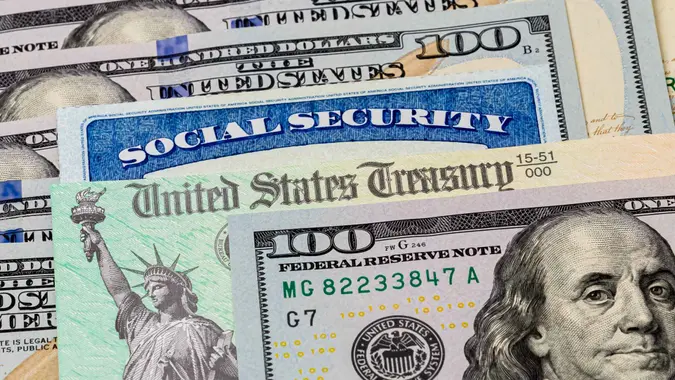How Many Rental Properties Do You Need to Retire?

Commitment to Our Readers
GOBankingRates' editorial team is committed to bringing you unbiased reviews and information. We use data-driven methodologies to evaluate financial products and services - our reviews and ratings are not influenced by advertisers. You can read more about our editorial guidelines and our products and services review methodology.

20 Years
Helping You Live Richer

Reviewed
by Experts

Trusted by
Millions of Readers
The number of rental properties needed to retire depends on your income goals, property cash flow and expenses. Real estate is a popular way to derive income in retirement because there is steady cash flow and asset appreciation. Much of how many rental properties you need to retire depends on your lifestyle — there is no one-size-fits-all answer.
This guide explains how to calculate your needs, the pros and cons of retiring with rental income, and tips to make it work.
Can You Retire on Rental Property Income?
Many retirees look to rental income as a way to fund their lifestyle, either as a supplement to other savings or as a full replacement for retirement income. The first step is to run the numbers: calculate how much rent is coming in and subtract expenses like taxes, insurance, maintenance, and vacancies. Once you know your net income, you can figure out whether one property will do the job or if you’ll need to build a portfolio of rentals to meet your retirement needs.
Key Benefits of Retiring on Rental Property Income
Owning rental properties can offer several advantages that make them especially appealing as part of a retirement plan:
- Built-in inflation protection. Rents often rise along with inflation, which helps your rental income keep pace with higher living costs.
- Steady monthly cash flow. With rent set in advance, you have a predictable income stream you can count on each month.
- Valuable tax breaks. Rental properties come with generous deductions, including mortgage interest, property taxes, maintenance costs, and even depreciation, which can lower your taxable income.
Key Drawbacks of Retiring on Rental Property Income
While rental income can be a strong source of retirement funding, it also comes with challenges you’ll need to plan for:
- Vacancies and downtime. Rental income isn’t always consistent — you may face empty months, especially during slower seasons.
- Ongoing maintenance. Keeping a property in good shape requires time and money for repairs, upgrades, and regular upkeep.
- Concentration risk. Depending on just one or two rentals can leave you vulnerable. Diversifying with multiple properties helps create a more stable income stream.
How to Calculate How Many Properties You Need to Retire
Here’s a step-by-step guide to calculating how many properties you need to retire:
- Determine desired annual retirement income. How much do you plan to spend on discretionary spending and essential spending? Total the amount you need for housing, food, health insurance and any spending that you dedicate toward discretionary spending.
- Subtract other income sources. Consider all your income sources like pension payments, Social Security benefits and rental income. Deduct this amount from your desired annual retirement income.
- Figure out how much each property actually brings in after expenses. How much are you receiving from your rental properties? Make sure you take the total amount of cash flow received from rental properties and deduct your expenses.
- Divide income gap by average property cash flow to find required number of
- properties. This number will tell you how many rental properties you will need to cover the gap.
How to Figure Out the Number of Rental Properties You’d Need to Retire
Let’s walk through a simple scenario:
- Retirement goal: $70,000 per year
- Other income (Social Security/pension): $20,000 per year
- Remaining need: $50,000 per year
Now, look at the numbers for a single property:
- Rent: $1,500/month
- Expenses (mortgage, taxes, insurance, repairs): $1,000/month
- Net cash flow: $500/month ($6,000/year)
With $50,000 still needed and $6,000 net income per property, you’d need about 8 to 9 properties.
Of course, the math changes based on your situation:
- If properties are paid off: Cash flow rises to $1,000 per month and only 4 to 5 properties needed
- If cash flow is smaller ($300/month): You may need over 12 properties
Factors That Affect How Many Properties You’ll Need
There are several factors that impact how many rental properties you will need to retire comfortably.
Your Living Expenses
How much do you spend each month? And what other income streams do you have including Social Security, pension payments and investment returns? Calculate your housing and food expenses, insurance requirements, healthcare, as well as discretionary spending for hobbies, general entertainment and travel.
Property Location and Rental Demand
Urban properties may attract higher demand than rural locations, which often means shorter vacancy periods and a steadier stream of tenants. In contrast, rentals in rural or seasonal markets may sit empty for months at a time, cutting into your annual cash flow.
Location not only affects how quickly you can fill a vacancy but also the kind of rent you can charge — strong demand in cities can support higher rental rates, while slower-moving markets may require lower rents to stay competitive. These factors directly influence how reliable your rental income will be in retirement.
Property Size and Type
The type of property you choose will impact both your income potential and the amount of work involved. Single-family homes usually have lower maintenance costs and fewer day-to-day issues, but because they rely on just one tenant, a vacancy means losing 100% of your rental income until it’s filled.
Multi-family properties, on the other hand, often require more upkeep and active management, but they can generate higher overall cash flow. Vacancies are also less disruptive since other units can still bring in income.
Maintenance and Vacancy Rates
Maintenance costs like HVAC replacements, roof repairs, or foundation issues can cause a significant drop in your rental income, especially if they’re unexpected. Even routine upkeep — like landscaping, appliance replacement, or plumbing repairs — adds up over time and needs to be budgeted for. On top of that, vacancies interrupt your cash flow, and depending on the market, it may take weeks or months to secure a new tenant.
For retirees who rely on steady rental income, both maintenance surprises and downtime between tenants can make cash flow less predictable, which is why having reserves or multiple properties can be critical.
Financing Terms and Whether Properties are Fully Paid Off
Fully paid-off properties generate higher net cash flow because you’re no longer sending part of the rent toward mortgage payments. This means more of the rental income stays in your pocket each month. If you’ve financed a property, however, a portion of your returns will always go toward loan repayment, reducing your immediate cash flow.
For retirees, the difference can be significant: owning properties outright provides more predictable income and less financial risk, while financed properties may offer leverage and growth potential but require careful planning to cover debt obligations.
Comparing Property Types for Retirement Income
When deciding what kind of property to invest in, it helps to understand how different types compare. Each option comes with its own balance of cash flow potential, management effort, and risk.
The table below breaks down some of the common property types and what you can generally expect from each:
| Property Type | Typical Cash Flow | Management Effort | Risk Level |
|---|---|---|---|
| Single-family home | Moderate | Lower | Moderate |
| Multi-family home | Higher | Medium | Higher vacancy turnover |
| Short-term Vacation Rentals | High, but seasonal | High | Tourism dependent |
Pros and Cons of Retiring with Rental Properties
Like any investment, relying on rental income in retirement comes with pros and cons you’ll need to weigh carefully.
Pros
- Steady stream of rental income to help cover expenses
- Potential property value appreciation that builds long-term wealth
- Ownership of a tangible asset you have control over
- Tax advantages through deductions on interest, taxes, maintenance, and depreciation
Cons
- Active management responsibilities, from finding tenants to handling issues
- Unexpected repair costs that can cut into profits
- Income fluctuations due to vacancies or inconsistent tenants
How to Plan Your Retirement Strategy with Rentals
The number of rental properties you’ll need ultimately depends on the income required to support your lifestyle. Because no two properties generate the same cash flow, it’s important to base your calculations on realistic numbers rather than best-case scenarios. A conservative approach will give you a clearer picture of how much income you can truly rely on.
For a plan that fits your specific goals and risk tolerance, consider working with a financial advisor or real estate professional who can help you balance rental income with your broader retirement strategy.
FAQ
- How much rental income do I need to retire comfortably?
- The amount depends on your lifestyle and expenses. Ideally, your rental income should cover your living costs after accounting for property expenses such as maintenance, vacancies, insurance, and taxes. Running a detailed cash flow analysis will give you a realistic target.
- Can I retire with just one or two rental properties?
- It’s possible, but often not enough for long-term stability. Most retirees need several properties to generate consistent income and reduce the risk of relying on just one tenant or property.
- Should I pay off rental property mortgages before retiring?
- Paying off mortgages can significantly increase your net cash flow in retirement since less money goes toward loan payments. However, keeping some financing in place may still make sense if it helps you grow your portfolio or maintain liquidity.
- Is it better to invest in long-term rentals or vacation rentals for retirement income?
- Long-term rentals typically provide steadier, more predictable income. Vacation rentals can offer higher returns during peak seasons but are more volatile and require more active management. The right choice depends on your market and how hands-on you want to be.
- How do taxes affect rental income in retirement?
- Rental income is generally taxable, but the tax code provides several deductions that can offset it. You may be able to write off expenses such as maintenance, depreciation, property taxes, and mortgage interest, which lowers your overall taxable income.
 Written by
Written by  Edited by
Edited by 

























